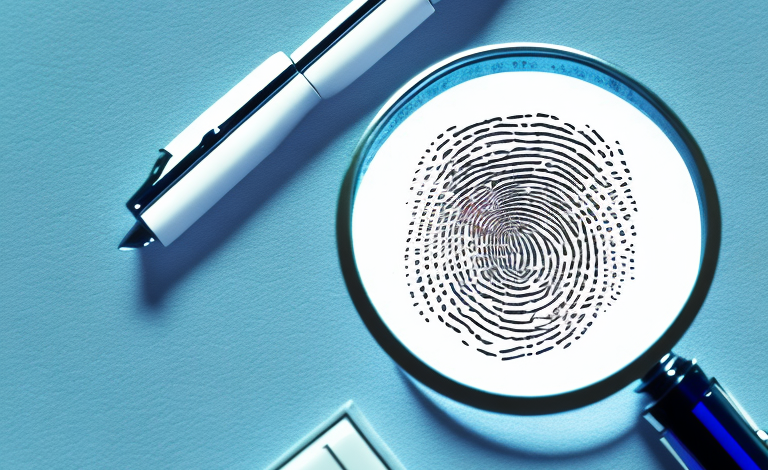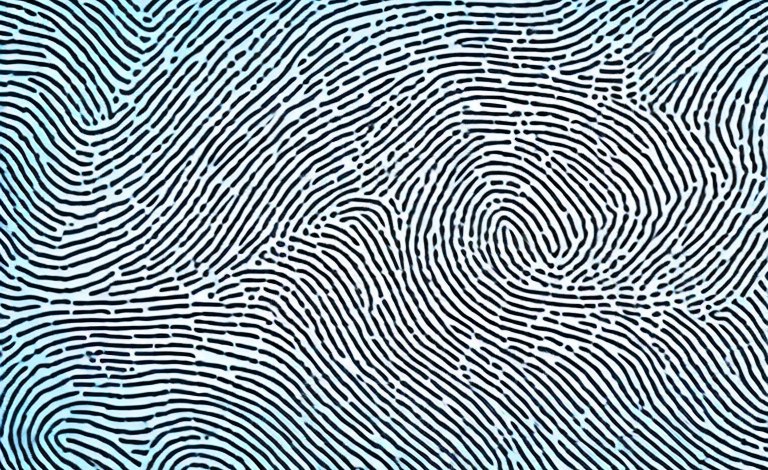Fingerprints have long been a vital tool in forensic science for identifying suspects in criminal investigations. Thanks to advancements in technology and rigorous scientific research, fingerprints have become one of the most reliable methods of identification available to law enforcement agencies and forensic analysts.
What are fingerprints and how do they work?
Fingerprints are unique patterns of ridges and valleys on the skin of the fingers, palms, and soles of the feet. These patterns, which are formed during fetal development, are completely unique to each individual, with no two people having the same fingerprints. The pattern of ridges and valleys is created by sweat ducts that open at the surface of the skin, producing sweat that forms distinctive patterns.
Fingerprint analysis works on the principle that the pattern of ridges and valleys on a fingerprint is unique to each individual. Therefore, by comparing the prints found at a crime scene with those of known individuals, it is possible to identify who was present at the scene.
In addition to being used in criminal investigations, fingerprints are also used for identification and security purposes. Many countries use fingerprints as a form of identification for passports and visas, and some companies use fingerprint scanners to control access to secure areas. Fingerprint technology has also been integrated into some smartphones, allowing users to unlock their devices with a simple touch of their finger.
The history of fingerprint identification and tracing
Fingerprint analysis was first used as a method of identification in the late 19th century. The first systematic method for classifying fingerprints was developed by Sir Francis Galton, a British scientist, in the 1890s. Since then, fingerprint analysis has become a critical tool in law enforcement, and a reliable method for establishing identity in both criminal and civil settings.
Advancements in technology have greatly improved the accuracy and efficiency of fingerprint analysis. Automated fingerprint identification systems (AFIS) were first introduced in the 1980s, allowing for faster and more accurate matching of fingerprints. Today, AFIS technology is widely used by law enforcement agencies around the world. Additionally, research is ongoing to develop new methods for analyzing fingerprints, such as using infrared light to detect hidden prints or analyzing the chemical composition of sweat left behind in a fingerprint.
The science behind fingerprint analysis and tracing
The analysis of fingerprints is based on the unique features and characteristics of each print. Forensic experts look for distinctive patterns, such as arches, loops, and whorls, as well as the presence of ridge characteristics, such as bifurcations and islands. These features are used to create a fingerprint profile, which can be compared against a database of known individuals to identify a suspect.
In addition to identifying suspects, fingerprint analysis can also be used to determine the cause of death in certain cases. For example, if a victim’s fingerprints are found on a weapon, it can be concluded that the victim was in contact with the weapon at the time of their death. This information can be crucial in determining whether the death was a homicide or a suicide.
Fingerprint analysis has come a long way since its inception in the late 19th century. Today, forensic experts use advanced technology, such as digital imaging and computer software, to enhance and analyze fingerprints. This technology has greatly improved the accuracy and speed of fingerprint analysis, making it an invaluable tool in criminal investigations.
The different types of fingerprints and their characteristics
There are three main types of fingerprints, each with its own distinct characteristics. These are arches, loops, and whorls. Arches are the simplest type of print, characterized by a basic curve that runs from one side of the finger to the other. Loops are more complex, with a single ridge that loops back on itself. Whorls are the most intricate, with ridges that form circular or spiraling patterns.
Each type of fingerprint can also be further classified into subcategories based on their specific characteristics. For example, arches can be divided into plain arches and tented arches, depending on the height of the ridges in the center of the print. Loops can be classified as radial loops or ulnar loops, depending on the direction of the loop in relation to the thumb. Whorls can be categorized as plain whorls, central pocket whorls, double loop whorls, and accidental whorls, depending on the number and location of the ridges.
Fingerprints are unique to each individual and can be used for identification purposes. The study of fingerprints is called dactyloscopy and is used in forensic science to help solve crimes. Fingerprint analysis involves comparing the patterns, ridges, and minutiae (small details) of a suspect’s fingerprints to those found at a crime scene. This process can help determine whether a suspect was present at the scene of a crime and can be used as evidence in court.
The process of collecting and analyzing fingerprints
The process of collecting fingerprints involves several steps. Forensic experts will first identify potential sources of prints, such as door handles, windowsills, and other surfaces that are frequently touched. Once a print has been located, a variety of techniques may be used to collect it, such as dusting with fingerprint powder or applying fingerprint tape. The prints are then analyzed using specialized software to create a profile that can be compared against a database of known individuals.
It is important to note that not all fingerprints are usable for analysis. Factors such as the surface texture, the amount of pressure applied, and the presence of oils or dirt can all affect the quality of the print. In some cases, multiple prints may need to be collected and analyzed in order to obtain a complete profile. Additionally, forensic experts must take care to properly handle and preserve the prints to ensure their accuracy and reliability in court proceedings.
The role of fingerprints in criminal investigations
Fingerprints are a critical tool in criminal investigations, used to identify suspects and establish a chain of custody for physical evidence. They are also used to link suspects to specific locations or objects. In many cases, fingerprints can be the key piece of evidence that leads to a conviction or exoneration.
Furthermore, fingerprints are unique to each individual and do not change over time, making them a reliable form of identification. The use of fingerprints in criminal investigations dates back to the early 1900s and has since become a standard practice in law enforcement. With advancements in technology, such as automated fingerprint identification systems, the process of identifying and matching fingerprints has become more efficient and accurate.
The accuracy and reliability of fingerprint identification
Fingerprint analysis is widely regarded as one of the most reliable methods of identifying individuals. The uniqueness of fingerprints has been scientifically proven, and rigorous standards and protocols have been established to ensure accuracy and reliability in the analysis process. However, like any method of identification, fingerprint analysis is not infallible, and errors can occur. It is essential that analysts follow established protocols and adhere to the highest standards of accuracy and objectivity.
Recent advancements in technology have greatly improved the accuracy and reliability of fingerprint identification. Automated fingerprint identification systems (AFIS) have been developed, which use computer algorithms to match fingerprints with a high degree of accuracy. These systems have greatly reduced the risk of human error and have increased the speed and efficiency of the identification process. However, it is important to note that AFIS systems are only as reliable as the data they are fed. It is crucial that law enforcement agencies maintain accurate and up-to-date fingerprint databases to ensure the effectiveness of these systems.
How long can fingerprints be stored in a database?
Fingerprints can be stored indefinitely in a database, with no deterioration in quality or loss of information over time. This makes them an incredibly valuable tool in both contemporary and historical investigations, as well as in long-term criminal intelligence gathering.
However, there are concerns about the privacy implications of storing fingerprints indefinitely. Some argue that it is a violation of civil liberties to keep such personal information on file without a clear and compelling reason to do so. Others worry that the potential for data breaches or misuse of the information could lead to serious harm.
Despite these concerns, fingerprint databases continue to be used by law enforcement agencies around the world. In some countries, such as the United States, there are strict regulations governing the collection, storage, and use of this data. However, in other parts of the world, there are fewer safeguards in place, which has led to controversy and criticism from civil liberties groups.
Factors that can affect the longevity of fingerprint traces
The longevity of fingerprint traces can be affected by a range of factors, including exposure to moisture, oils, and chemicals, as well as environmental factors such as dust and sunlight. Factors such as age, health, and occupation can also affect the clarity and quality of fingerprints.
Legal considerations regarding the use of fingerprints in investigations
The use of fingerprints in criminal investigations is subject to strict legal considerations, such as the right to due process, the right to privacy, and the principles of evidence admissibility. Strict protocols must be followed in the collection, storage, and analysis of fingerprints to ensure that they are admissible in court.
Emerging technologies that are changing the landscape of fingerprint analysis
Advancements in technology are rapidly changing the way fingerprints are analyzed and interpreted. Developments in machine learning and artificial intelligence, for example, are enabling forensic experts to more rapidly and accurately identify and compare fingerprints. Other technologies, such as advanced imaging and chemical analysis techniques, are also expanding the field of fingerprint analysis and identification.
The future of fingerprint tracing: challenges and opportunities
The future of fingerprint tracing is full of both challenges and opportunities. As technology continues to advance, the capabilities of forensic experts in this field will expand, allowing more in-depth analysis and identification of prints. However, there will also be challenges to overcome, particularly in the area of privacy and data protection.
Frequently asked questions about fingerprint identification and tracing
Q: Can fingerprints be altered or removed?
A: While it is possible to alter or remove fingerprints through extreme measures such as surgery or acid burn, these methods are neither practical nor effective.Q: Can two people have the same fingerprints?
A: No, it is virtually impossible for two people to have the same fingerprints.Q: Can fingerprints be faked?
A: While it is possible to fake fingerprints using a variety of methods, such as using prosthetics or artificial prints, these methods are generally ineffective and can be easily detected by forensic experts.Q: Can fingerprints be used to determine age or gender?
A: While fingerprints can provide some information about a person’s age or gender, they are not reliable indicators and are generally not used for this purpose.
Conclusion
In conclusion, fingerprints are an integral part of forensic science and the criminal justice system. They have been used for over a century as a reliable and accurate method of identifying suspects and establishing guilt or innocence. As technology advances and new techniques and methods are developed, we can expect to see even greater accuracy and reliability in the analysis and identification of fingerprints, further solidifying their place as a vital tool in solving crimes and delivering justice.



